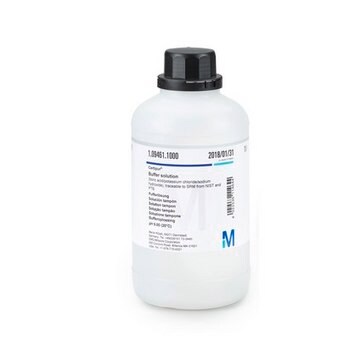1.07294
Buffer solution
di-sodium hydrogen phosphate/potassium dihydrogen phosphate, traceable to NIST, traceable to PTB, pH 6.88 (20 °C), Certipur®
Synonym(s):
di-sodium hydrogen phosphate/potassium dihydrogen phosphate buffer, pH 6.88 calibration standard solution
About This Item
Recommended Products
grade
certified reference material
Quality Level
agency
traceable to NIST
traceable to PTB
product line
Certipur®
composition
di-sodium hydrogen phosphate/potassium dihydrogen phosphate
pH
6.88 (20 °C)
application(s)
environmental
food and beverages
general analytical
industrial qc
pharmaceutical
format
mixture
storage temp.
15-25°C
General description
The ready-to-use Certipur® buffer solutions are prepared gravimetrically in our ISO/IEC 17025 accredited calibration laboratory from high-purity salts, acids and bases diluted in high-purity water. All balances are regularly calibrated with analytical weight sets traceable to primary standard reference materials from NIST and PTB. The pH-value is measured to the highest precision using a combined glass electrode after 5-point calibration (according to DIN 19268) against reference buffer solutions (according to DIN 19266, IUPAC, NIST, Ph.Eur. and USP).
Download your certificate at http://www.sigma-aldrich.com to view certified values, including uncertainty and expiry date.
Features and Benefits
- Compliant: Produced according to EP and USP guidelines
- Secure: Tested in our ISO 17025 accredited calibration laboratory
- Ready for audits: Detailed certificate of analysis for every product
- Convenient: Simply open the pack for quick, accurate pH calibration
Legal Information
recommended
Storage Class
12 - Non Combustible Liquids
wgk_germany
nwg
flash_point_f
Not applicable
flash_point_c
Not applicable
Certificates of Analysis (COA)
Search for Certificates of Analysis (COA) by entering the products Lot/Batch Number. Lot and Batch Numbers can be found on a product’s label following the words ‘Lot’ or ‘Batch’.
Already Own This Product?
Find documentation for the products that you have recently purchased in the Document Library.
Customers Also Viewed
Our team of scientists has experience in all areas of research including Life Science, Material Science, Chemical Synthesis, Chromatography, Analytical and many others.
Contact Technical Service











